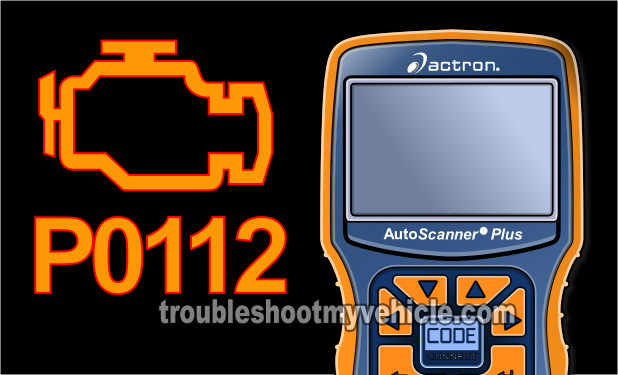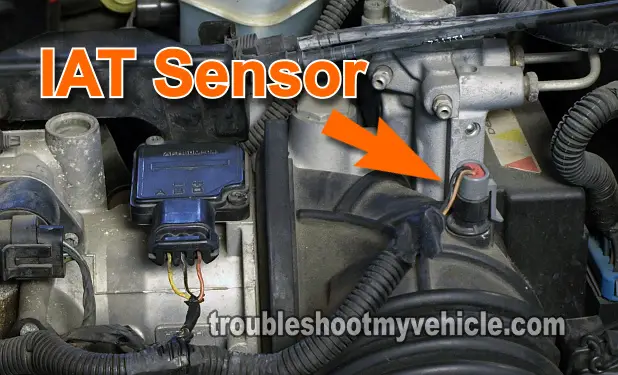
OBD II trouble code P0112 Intake Air Temperature Circuit Low Input usually points to a failed intake air temperature (IAT) sensor, but not always. In some cases, the IAT sensor's wiring is at fault.
In this tutorial, I'm gonna' show you some of the basics you need to know about what DTC P0112 means and several step-by-step tests that'll show you how to troubleshoot and solve the problem.
Contents of this tutorial:
- P0112 Basics You Need To Know.
- Symptoms Of A P0112 Diagnostic Trouble Code.
- Where To Buy The Intake Air Temp Sensor And Save.
- Common Causes Of A P0112 Trouble Code.
- Troubleshooting P0112: Intake Air Temperature Circuit Low Input.
- TEST 1: Checking The Intake Air Temperature Value.
- TEST 2: Checking The Condition Of The IAT Sensor's 2 Wires.
- TEST 3: Disconnecting the IAT Sensor From Its Connector.
- More 3.8L V6 GM Tutorials.
P0112 Basics You Need To Know

The IAT sensor's job is to sense and report the temperature of the air entering the engine. Why does the fuel injection computer need to know this temperature? This is because the warmer the air, the less fuel the PCM (Powertrain Control Module = Fuel Injection Computer) needs to inject into the cylinders.
So, when a code P0112 lights up the check engine light (CEL), the PCM is letting you know that there's a malfunction in the temperature value that the intake air temperature sensor (IAT) is reporting to the PCM.
Specifically, that the IAT sensor is reporting that the temperature of the air entering the engine is around 300 °F (148 °C). Yeah, that's pretty hot!!
Here are some more details on how the intake air temperature (IAT) sensor works:
- The intake air temperature (IAT) sensor is a 2 wire sensor.
- One wire (circuit) supplies power. This power is in the form of 5 Volts DC (which come from the PCM).
- The other wire (circuit) supplies Ground. The PCM supplies this Ground internally.
- The IAT sensor is a resistor. Its resistance changes in response to changes in the air's temperature.
- The cooler the air, the higher the resistance of the IAT sensor.
- The warmer the air, the lower the resistance of the IAT sensor.
- When the 5 Volts pass through the intake air temperature (IAT) sensor, the resistance of the sensor produces a voltage drop. This in plain English means that only a certain amount of the 5 Volts are let through to the Ground wire.
- The cooler the air is, the less voltage is let thru' onto the Ground wire (due to the IAT sensor's higher resistance).
- The PCM translates this higher voltage drop into a colder temperature value.
- The warmer the air, the more voltage is let thru' onto the Ground wire (due to the IAT sensor's lower resistance).
- The PCM translates this lower voltage drop into a warmer/hotter temperature value.
- The cooler the air is, the less voltage is let thru' onto the Ground wire (due to the IAT sensor's higher resistance).
So, when a P0112 Intake Air Temperature Circuit Low Input is stored in the PCM memory, the PCM is letting you know that the intake air temperature (IAT) sensor is reporting an extremely low voltage drop (think IAT sensor wires shorted together).
The PCM interprets this condition as an extremely hot air temperature (above 200 °F).
Symptoms Of A P0112 Diagnostic Trouble Code
A bad intake air temperature (IAT) sensor, that's reporting an extremely hot air temperature (above 200 °F), will have negative consequences on the air/fuel mixture that the PCM is trying to control.
The symptoms of a bad intake air temperature (IAT) sensor are:
- Check engine light (CEL) is on.
- DTC P0112 is present.
- Won't pass the state mandated emissions test.
- Gas mileage will suffer.
- Rough idle.
- Hard start and/or extended cranking time.
- Black smoke coming out of the tailpipe.
Let's find out what are the common causes of a P0112 DTC, in the next subheading.
Where To Buy The Intake Air Temp Sensor And Save
There's a good chance that you can buy the original AC Delco (Delphi) intake air temperature (IAT) sensor online for a whole lot cheaper than somewhere local.
The following links will help you comparison shop for the AC/Delco (Delphi) and aftermarket IAT sensor:
Disclosure: As an Amazon Associate, I earn from qualifying purchases. If my tutorials help you, using these links is an easy way to support the site at no extra cost to you. Thank you!
Common Causes Of A P0112 Trouble Code
Here are the most common causes of a P0112 diagnostic trouble code (DTC):
- Bad intake air temperature sensor.
- Intake air temperature sensor wires have shorted together.
- What usually happens is that the rubber insulation around the IAT sensor's 2 wires have dry-rotted and has peeled off. This exposes the copper wire and at some point, these two short together (this is a very common problem).
- Bad PCM (Powertrain Control Module = Fuel Injection Computer).
- This is very rare, but it does happen.
With this basic info under our belts, let's turn the page and get testing!



